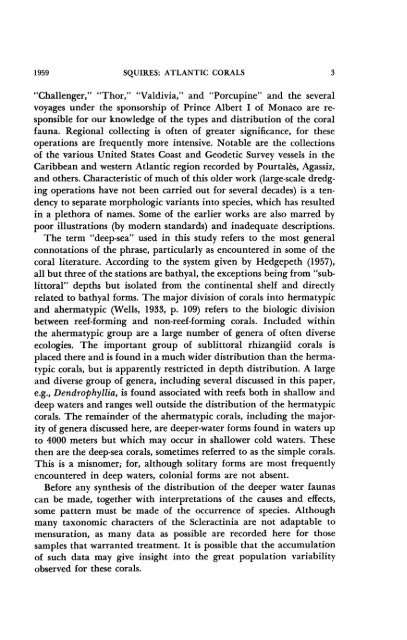MXieuicanJAuscum - American Museum of Natural History
MXieuicanJAuscum - American Museum of Natural History
MXieuicanJAuscum - American Museum of Natural History
Create successful ePaper yourself
Turn your PDF publications into a flip-book with our unique Google optimized e-Paper software.
1959 SQUIRES: ATLANTIC CORALS<br />
3<br />
"Challenger," "Thor," "Valdivia," and "Porcupine" and the several<br />
voyages under the sponsorship <strong>of</strong> Prince Albert I <strong>of</strong> Monaco are responsible<br />
for our knowledge <strong>of</strong> the types and distribution <strong>of</strong> the coral<br />
fauna. Regional collecting is <strong>of</strong>ten <strong>of</strong> greater significance, for these<br />
operations are frequently more intensive. Notable are the collections<br />
<strong>of</strong> the various United States Coast and Geodetic Survey vessels in the<br />
Caribbean and western Atlantic region recorded by Pourtales, Agassiz,<br />
and others. Characteristic <strong>of</strong> much <strong>of</strong> this older work (large-scale dredging<br />
operations have not been carried out for several decades) is a tendency<br />
to separate morphologic variants into species, which has resulted<br />
in a plethora <strong>of</strong> names. Some <strong>of</strong> the earlier works are also marred by<br />
poor illustrations (by modern standards) and inadequate descriptions.<br />
The term "deep-sea" used in this study refers to the most general<br />
connotations <strong>of</strong> the phrase, particularly as encountered in some <strong>of</strong> the<br />
coral literature. According to the system given by Hedgepeth (1957),<br />
all but three <strong>of</strong> the stations are bathyal, the exceptions being from "sublittoral"<br />
depths but isolated from the continental shelf and directly<br />
related to bathyal forms. The major division <strong>of</strong> corals into hermatypic<br />
and ahermatypic (Wells, 1933, p. 109) refers to the biologic division<br />
between reef-forming and non-reef-forming corals. Included within<br />
the ahermatypic group are a large number <strong>of</strong> genera <strong>of</strong> <strong>of</strong>ten diverse<br />
ecologies. The important group <strong>of</strong> sublittoral rhizangiid corals is<br />
placed there and is found in a much wider distribution than the hermatypic<br />
corals, but is apparently restricted in depth distribution. A large<br />
and diverse group <strong>of</strong> genera, including several discussed in this paper,<br />
e.g., Dendrophyllia, is found associated with reefs both in shallow and<br />
deep waters and ranges well outside the distribution <strong>of</strong> the hermatypic<br />
corals. The remainder <strong>of</strong> the ahermatypic corals, including the majority<br />
<strong>of</strong> genera discussed here, are deeper-water forms found in waters up<br />
to 4000 meters but which may occur in shallower cold waters. These<br />
then are the deep-sea corals, sometimes referred to as the simple corals.<br />
This is a misnomer; for, although solitary forms are most frequently<br />
encountered in deep waters, colonial forms are not absent.<br />
Before any synthesis <strong>of</strong> the distribution <strong>of</strong> the deeper water faunas<br />
can be made, together with interpretations <strong>of</strong> the causes and effects,<br />
some pattern must be made <strong>of</strong> the occurrence <strong>of</strong> species. Although<br />
many taxonomic characters <strong>of</strong> the Scleractinia are not adaptable to<br />
mensuration, as many data as possible are recorded here for those<br />
samples that warranted treatment. It is possible that the accumulation<br />
<strong>of</strong> such data may give insight into the great population variability<br />
observed for these corals.
















